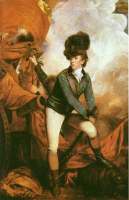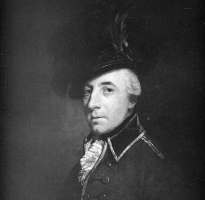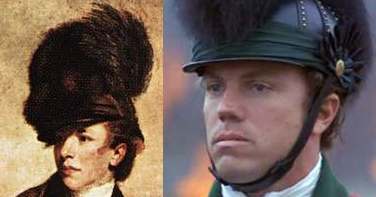


| [ Previous ] [ Next ] |

|
 [enlarge] |
The uniform of the British Legion could be said to be both famous and obscure. Virtually everyone interested in the Revolution has seen it illustrated in the Reynolds portrait of Banastre Tarleton, yet there are few contemporary descriptions of it to be found. Having received a number of email questions about Legion uniforms, I have pulled together what little I can find in the way of solid documentation. It's not much and, as ever, additions and corrections are welcome.
At the beginning of the Revolution, green coats were common for provincial regimental uniforms, but during the early years of the war, London made the decision to switch Provincials over to red coats. This may have been driven in part by a desire to make the Provincials, who were doing critical service in the war, feel more a part of the regular army. The predominant motive, though, was more likely one of practical logistics. Ordering cloth or uniforms in one standard color meant that they could more easily be finished and shipped to whatever regiment required them.
In 1776-82, the concept of "standard" military uniforms was still fairly new. Prior to Hanoverian rule, colonels dressed their regiments pretty much as they wished. The Hanoverian kings gradually reduced that freedom and mandated standards for military dress. By the period of the Revolution, the familiar British army uniform of red coat with white small clothes had become the accepted norm, but regimental colonels (and even individual officers) still had considerable leeway in terms of adapting and personalizing the details, such as cut and braid. And there were always a few regiments that were able to retain completely "non regulation" uniforms due to the weight of regimental history, their colonel's connections at Court, or his simple persuasiveness.1
 [enlarge] |
The same practice held within the Provincials. Most regiments accepted the new orders without argument and switched over to red coats. John Graves Simcoe, however, successfully argued against the change. In his Journal, he wrote that:
It being determined, for the next year, to cloth the Provincials in red, Major Simcoe exerted himself to preserve the Rangers in green, [...] green is without comparison the best color for light troops with dark accouterments; and if put on in the spring, by autumn it nearly fades with the leaves, preserving its characteristic of being scarcely discernable at a distance.2
Throughout his Journal, Simcoe emphasizes the advantages of the Queen's Rangers uniform color, both as camouflage in heavily forested terrain and because of the perception by the enemy that all British soldiers wore red. (A misconception carried right through to modern times, in films such as The Patriot.)
Simcoe had no qualms about taking advantage of this misconception and using it to his advantage:
Major Simcoe [...] left the infantry of his party at the edge of the wood, and approached a house; the owner of it, who supposed that all the British soldiers wore red, was easily imposed upon to believe him a rebel officer [.]3
Simcoe's success is relevant to the British Legion because of timing. During the early months of the Legion's existence its cavalry wing camped near and operated closely in concert with the Queen's Rangers. This may have influenced the original decision to give them uniforms very similar to those worn by the Rangers, and when Simcoe successfully argued against the color change, Tarleton's men also retained their green jackets.
As I have mentioned, only a few contemporary descriptions of the uniforms survive. On September 7, 1780, the Boston Independent Chronicle and the Universal Advertiser ran a description of three Loyalist prisoners of war who had just escaped from the Concord jail:
Broke out of the Gaol in this Town, on the Night of the 3d Instant, the following British Officers, Prisoners of War, viz -- Capt. Thomas Sandford, Lieut. Hugh Davis, and Lieut. John Miller. Said Sandford had on a red Coat, trimmed with silver, and Nankeen Waistcoat and Overalls, about 5 Feet 9 Inches high, brown Hair; Davis and Miller had on short green Coats trimmed with narrow Gold Lace, and Nankeen Waistcoats and Overalls, , about 5 Feet 9 Inches high, brown hair. Ephriam Jones, Dep Goaler, Concord, September 4, 1780"4
Davis and Miller wore the standard Legion cavalry uniform, and this verbal description meshes well with the details as painted by Reynolds. It is interesting to note that Sandford wore the standard Provincial red even though his Bucks County Light Dragoons had been attached to first the Queen's Rangers and later the British Legion since 1779.
A few weeks earlier the Independent Chronicle had noted the escape of Lt. Samuel Chapman and described his dress as "a short green coat trimmed with narrow gold lace, a fur cap, [and] boots." In October, 1780, an English newspaper article about the Legion described their dress as "uniforms are a tight green waistcoat, without skirts, with black cuffs and cape, and nothing more." And finally, in 1780, the Legion was sent five hundred new uniforms, described in the supply paperwork as consisting of "green jackets and waistcoats laced, best made buckskin breeches." Buckskin was no doubt considerably more practical for field wear than the pristine white breeches Tarleton is shown wearing by Reynolds, though the unit's clothing warrants for 1781 and 1782 did specify the issuing of white breeches.5
So all in all, the Reynolds seems to provide quite an authentic representation of the uniform. Hanger's portrait shows some variations on the cut of the jacket and the accouterments. These could be due to the personalization still allowed to individual officers, or to one or the other painters applying minor artistic licence to their images.
On a side note: While describing the campaign in Virginia, Simcoe makes a comment in his journal that "Col. Tarleton's legion were mostly clothed in white." At the time, Cornwallis's army in general and the Legion in particular were in dire need of uniforms and equipment. They had already endured a lengthy campaign without resupply. They were also fighting through the heat of summer. In response to these two circumstances, they may have dispensed with their uniform jackets, possibly replacing them with hunting shirts. So far as I know, there is no other documentation to clarify Simcoe's meaning.6
There is considerably more argument among modern historians and re-enactors about the details of the infantry uniform. Carman quotes the only two contemporary descriptions of them which I have encountered:
"The issue of March 1782 for clothing was described as 'Green Light Infantry Coats & Jackets, Black Collar & Cuffs & white Breeches'" and another from "Rivington's Army List" for 1783: "British Legion Infantry -- Short Coat, Green with Same Lappel, Variety Button hole & Black Cuff and Collar."7
I have encountered speculation that the Legion infantry may have worn red jackets at some point, but I could find no documentation to support this theory, and so can say nothing about it.
No descriptions or samples of Legion uniform buttons survive. Carman speculates that "They may have had the general issue type of 'Crown over R.P.' (Royal Provincials) or a special design known to be worn by other 'American' Regiments."8
Perhaps the most eye-catching element of the Legion uniform is its flashy, crested helmet. Variations on this helmet design remained popular with cavalry regiments until the middle of the Napoleonic wars, but while it became known as the "Tarleton helmet" it seems improbable that Tarleton had anything to do with its invention. The exact origin of the helmet is obscure. The earliest illustration of it that I can discover is that showing the Capture of Charles Lee by the 16th Light Dragoons. Tarleton served with the 16th as a volunteer, so he may have liked the headgear and influenced its incorporation into the design of the Legion uniform.

Tarleton helmets, Reynolds vs Hollywood |
The version Ban wears in the Reynolds portrait consists of a peaked, black jockey cap (not unlike a modern baseball cap) made of boiled leather, with a strip of green fabric known as a turban encircling the rim. The turban is decorated with gilt chains. The cap is surmounted with a roll of black bearskin, and the side decorated with a clump of swan feathers. (Tarleton's portrait shows them as green backed by black, while Hanger's are all green.)
When they reproduced the helmets for The Patriot, Hollywood added a chin strap, but there is no indication that those were worn contemporarily. I have seen a passing mention of William Washington wearing a chin strap -- the matter came up when it broke in battle, and he was forced to dismount to retrieve it -- but in general they did not become common until the Napoleonic Wars, by which time helmets had grown tall, elaborate and heavy. If anything was needed to keep the Legion helmets in place, it is more likely to have been a small, unobtrusive ribbon tied around the back of the head, beneath the man's queue.
The appearance of the helmets is certainly decorative but it was also functional. The boiled leather cap gave some protection against a sword blow without adding excess weight. The rolled bearskin provided additional cushioning from a blow, while its long, waving fur and feathers would have served to camouflage the exact shape of the wearer's skull from an enemy marksman or swordsman.
A number of people have also written tasking for information on the regimental colours of the Legion. Unfortunately, I have nothing to supply. The standards for regimental colours within the regular army is known, but there is very little information in general about the colours of Provincial regiments, and none that I can find which specifically reference the British Legion.
Considerable speculation has flown around concerning the banners shown in the background of the Reynolds painting of Tarleton. While it is generally invisible in photo reproductions, a visit to the original painting shows that there is a large, decorative "L" embossed on the scarlet flag in the left rear of the image. This has led some to the conclusion that it represents the Legion's flag, but this is unlikely since it is too far removed from the standards of the time. Carman's article includes a lengthy discussion of possibilities for the various banners shown by Reynolds, speculating that those lying on the ground probably represent captured enemy flags. He runs into more difficulty with the waving banner:
In the centre is a large cursive "L" within the thin leavy branches. Above the horse's nostrils are two cannon painted and pointed to the rear. A very rudimentary crown is half-hidden in the upper folds of the flag. There is a "canton" which may be intended as white although in some prints it appears as yellow. In this rectangle is a grey-brown bird which appears to be an American eagle (although it has been called a swan in one modern source). This hardly seems right for the British Legion. [...] It could be said that the "L" stood for "Legion" but as there were other legions especially in the American forces, a single "L" is not much of a distinction.
The Lauzun Legion came in close contact with Tarleton and the Legion of Pulaski was "surprised and destroyed at Monk's Corner" according to a letter from Tarleton. Details are not known of the Lauzun flag but that of Pulaski's Legion was all-red with yellow decoration. Could the "L" stand for Lauzun? Not if the crown is a correct rendering.9
Carman's ultimate conclusion is simply that "Perhaps the trophies are symbolical and imaginary, just to indicate the sitters' victories." That seems a logical speculation, and I can offer nothing better.10
| [ Index ] | [ Previous ] [ Next ] |
1 White "small clothes" -- i.e. waistcoat and breeches -- were introduced during the 1760s. Before that, the standard uniform had included a scarlet waistcoat and breeches. [ back ]
2 John Graves Simcoe, A History of the Operations of a Partisan Corps called the Queen's Rangers (New York: Bartlett & Welford, 1844), p38. [ back ]
4 A. W. Haarmann, "British Legion Cavalry and Bucks County Light Dragoons; Uniforms, 1780", Journal of the Society for Army Historical Research 47: 60, and Military Collector and Historian, 21 (1969) each quote slight variants on the newspaper notice. Thanks to Don Gara for sending me a transcription of the latter version. [ back ]
5 W.Y. Carman, "Banastre Tarleton and the British Legion," Journal of the Society for Army Historical Research 62 (1984):129, quoting various contemporary papers. [ back ]
| Return to the Main Page | Last updated by the Webmaster on September 30, 2004 |